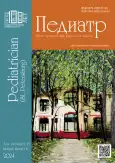Functional condition of the cardiovascular system in children who have had a new coronavirus infection
- Authors: Kaladze N.N.1, Aleshina O.K.1, Revenko N.A.1, Lebedeva O.D.1, Mishin N.P.1
-
Affiliations:
- V.I. Vernadsky Crimean Federal University
- Issue: Vol 15, No 6 (2024)
- Pages: 33-40
- Section: Original studies
- URL: https://journal-vniispk.ru/pediatr/article/view/312823
- DOI: https://doi.org/10.17816/PED15633-40
- ID: 312823
Cite item
Abstract
BACKGROUND: It is known that in March 2020, a new coronavirus infectious disease that spread across the continent received the status of a pandemic. It has already been established that the new coronavirus infection has features not only in the acute period, but also much later after its expiration.
AIM: to study some functional parameters of the cardiovascular system in children who have suffered a new coronavirus infection, depending on the presence of subjective manifestations.
MATERIALS AND METHODS: We examined 84 children with a history of a new coronavirus infection aged 7 to 17 years. The average age is 11.57 ± 0.46 years. The children were divided into groups 1 (it is a group without subjective manifestations (without complains in time firstable examination) and 2 (with subjective manifestations (with complains)). To identify functional disorders, pulse oximetry, load tests of Shtange and Genchi and bicycle ergometry, electrocardiogram of rest and with load, Holter monitoring were performed for all children.
RESULTS: In the groups of children who underwent new coronavirus infection, a significant decrease in respiratory retention was found during the Shtange’s and Genchi’s tests, physical performance and maximum oxygen consumption in patients with subjective manifestations., an increase in the frequency of cardiac arrhythmias in comparison with the resting electrocardiogram before the infection. Ventricular extrasystole was also detected during Holter monitoring in 2 (2,4 %) children.
CONCLUSIONS: Functional disorders were revealed in all examined children who had a new coronavirus infection in the form of a significant decrease in respiratory retention in the Shtange’s and Genchi’s samples, bicycle ergometry indicators and the appearance of some cardiac arrhythmias, more pronounced in the group of patients with subjective manifestations.
Full Text
##article.viewOnOriginalSite##About the authors
Nikolai N. Kaladze
V.I. Vernadsky Crimean Federal University
Author for correspondence.
Email: evpediatr@rambler.ru
ORCID iD: 0000-0002-4234-8801
SPIN-code: 5133-3829
MD, PhD, Dr. Sci. (Medicine), Professor, Head of Pediatrics Dept. of Pediatrics, Physiotherapy and Health Resorts Faculty of Postgraduate Education, Federal State Autonomous Institution of Higher Education
Russian Federation, SimferopolOlga K. Aleshina
V.I. Vernadsky Crimean Federal University
Email: laguna_15@mail.ru
ORCID iD: 0000-0002-3966-8310
SPIN-code: 8268-8809
MD, PhD, Associate Professor, Department of Pediatrics Propedeutics, Federal State Autonomous Institution of Higher Education
Russian Federation, SimferopolNatalya A. Revenko
V.I. Vernadsky Crimean Federal University
Email: shagal-75@mail.ru
ORCID iD: 0000-0003-3218-3123
SPIN-code: 8958-0529
MD, PhD, Associate Professor, Department of Pediatrics with a childhood infectious diseases course, Federal State Autonomous Institution of Higher Education
Russian Federation, SimferopolOlga D. Lebedeva
V.I. Vernadsky Crimean Federal University
Email: medleb@mail.ru
ORCID iD: 0000-0002-0721-6424
SPIN-code: 3827-9867
MD, PhD, Associate Professor, Department of Pediatrics with a childhood infectious diseases course, Federal State Autonomous Institution of Higher Education
Russian Federation, SimferopolNikolay P. Mishin
V.I. Vernadsky Crimean Federal University
Email: mishinnick@yandex.ru
ORCID iD: 0000-0003-4033-1157
SPIN-code: 3462-6516
Senior Teacher, Department of Theory and Methods of Physical Culture, Federal State Autonomous Institution of Higher Education
Russian Federation, SimferopolReferences
- Bagdasaryan AS, Sirunyants AA, Pukhnyak DV, et al. Cardiovascular COVID-19 syndrome after-effects. Emergency medical care. 2022; 23(1):19–26. doi: 10.24884/2072-6716-2022-23-1-19-26 EDN: QNQHTR
- Baryshnikova GA, Chorbinskaya SA, Zimina TA, et al. COVID-19: the place of metabolic correctors in the therapy of patients with post-covid syndrome. The Attending Physician. 2022;(3):80–66. doi: 10.51793/OS.2022.25.3.013 EDN: EBVOEL
- Zakharova IN, Osmanov IM, Tvorogova TM, et al. Post-covid syndrome in children in rare cases of COVID-19. Pediatrics. Consilium Medicum. 2022;(1):8–14. doi: 10.26442/26586630.2022.1.201515 EDN: BKNIBJ
- Zolotareva YuA, Mokasheva EN. Features of the course of coronavirus infection against the background of chronic pathology. European Journal of Natural History. 2022;(1):53–58. EDN: URMPWS
- Ivanova ON. Post-COVID syndrome in children. International Research Journal. 2021;(9–2):35–39. doi: 10.23670/IRJ.2021.9.111.040 EDN: SFNKUA
- Karelina S, Kashpur Ya, Kosareva E. Analysis of statistical data for the epidemic period from 2020 to 2023 of the new coronavirus infection on the territory of the Russian Federation and its subjects according to the data of the media. Universum: medicine and pharmacology. 2023;(4–5):42–46. EDN: UEPXJG
- Tsapaev VG, Tsapaeva NL. Some ideas how to overcome the post-virus syndrome of COVID-19. Recipe. 2021;24(4):451–461. doi: 10.34883/PI.2021.24.4.003 EDN: CXHHHY
- Kalter L. Fauci introduces new acronym for long COVID at white house briefing. Available from: https://www.medscape.com/viewarticle/946419
- Tenforde M, Kim S, Lindsell C, et al. Symptom duration and risk factors for delayed return to usual health among outpatients with COVID-19 in multistate health care systems network — United States. MMWR. 2020;69(30):993–998. doi: 10.15585/mmwr.mm6930e1
Supplementary files













